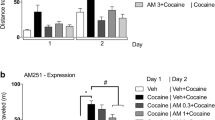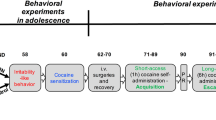Abstract
Rationale
There are marked individual differences in the efficacy of mainstream nicotine cessation agents in preventing relapse. A rat model of novelty-seeking phenotype was reported to have predictive value for psychostimulant taking behavior where locomotor reactivity to novelty is used to rank high (HR, highest 1/3) versus low (LR, lowest 1/3) responsiveness to novelty in outbred rats. We tested the hypothesis that a cannabinoid receptor (CB) 1 antagonist that is in clinical trials for smoking cessation may reverse behaviorally sensitizing effects of nicotine in HRs and repeated nicotine-induced elevations in hippocampal 5HT.
Materials and methods
Adolescent LRHR rats underwent intermittent behavioral sensitization to nicotine regimen with or without a CB1 receptor antagonist AM251 or bupropion treatment following nicotine training during 1 week of nicotine-free period. Expression of behavioral sensitization to nicotine was assessed in response to a low-dose nicotine challenge. Using the same sensitization regimen and therapeutic treatments, hippocampal 5HT levels were measured via in vivo microdialysis in response to the nicotine challenge.
Results
HR but not LR animals showed behavioral sensitization to a low-dose nicotine challenge following intermittent nicotine training and 1 week of injection-free period. AM251 (5 mg/kg, i.p.) but not bupropion administration during injection-free period successfully reversed locomotor sensitization to nicotine challenge in HRs. AM251 treatment also reversed nicotine-induced elevations in extracellular 5HT in the HR hippocampal hilus.
Conclusion
These data suggest that CB1 antagonists may prevent locomotor sensitization to nicotine and reverse nicotine-induced elevations in hippocampal 5HT in high novelty seekers.





Similar content being viewed by others
References
Balfour DJK, Ridley DL (2000) The effects of nicotine on neural pathways implicated in depression: a factor in nicotine addiction? Pharmacol Biochem Behav 66:79–85
Ballaz S, Akil H, Watson SJ (2007) Analysis of 5HT6 and 5HT7 receptor gene expression in rats showing differences in novelty-seeking behavior. Neuroscience 147:428–438
Bhatti AS, Hall P, Ma Z, Tao R, Isgor C (2007) Hippocampus modulates the behaviorally-sensitizing effects of nicotine in a rat model of novelty-seeking: potential role for mossy fibers. Hippocampus 17:922–933
Brody AL, Mandelkern MA, Lee G, Smith E, Sadeghi M, Saxena S et al (2004) Attenuation of cue-induced cigarette craving and anterior cingulate cortex activation in bupropion-treated smokers: a preliminary study. Psychiatry Res 130:269–281
Brog JS, Salyapongse A, Deutch AY, Zahm DS (1993) The patterns of afferent innervation of the core and shell in the “accumbens” part of the ventral striatum: immunohistochemical detection of retrogradely transported Fluoro-Gold. J Comp Neurol 338:255–278
Castane A, Valjent E, Ledent C, Parmentier M, Maldonado R, Valverde O (2002) Lack of CB1 cannabinoid receptors modifies nicotine behavioral responses, but not nicotine abstinence. Neuropharmacology 43:857–867
Cohen C, Perrault G, Voltz C, Steinberg R, Soubrie P (2002) SR141716, a central cannabinoid (CB(1)) receptor antagonist, blocks the motivational and dopamine-releasing effects of nicotine in rats. Behav Pharmacol 13:451–463
Covey LS (1999) Tobacco cessation among patients with depression. Prim Care 26:691–706
Cryan JF, Gasparini F, van Heeke G. Markou A (2003) Non-nicotinic neuropharmacological strategies for nicotine dependence: beyond bupropion. DDT 8:1025–1034
Dwoskin LP, Rauhut AS, King-Pospisil KA, Bardo MT (2006) Review of the pharmacology and clinical profile of bupropion, an antidepressant and tobacco use cessation agent. CNS Drug Rev 12:178–207
Egertova M, Elphick MR (2000) Localization of cannabinoid receptors in the rat brain using antibodies to the intracellular C-terminal tail of CB1. J Comp Neurol 422:159–171
Fabian-Fine R, Skehel P, Errington ML, Davies HA, Sher E, Stewart MG et al (2001) Ultrastructural distribution of the alpha7 nicotinic acetylcholine receptor subunit in rat hippocampus. J Neurosci 21:7993–8003
File SE, Kenny PJ, Ouagazzal A-M (1998) Anxiolytic and anxiogenic effects of nicotine in the social interaction test: role of the dorsal hippocampus. Behav Neurosci 112:1423–1429
Gobbi G, Bambico FR, Mangieri R, Bortolato M, Campologno P, Solinas M et al (2005) Antidepressant-like activity and modulation of brain monoaminergic transmission by blockade of anandamide hydrolysis. Proc Natl Acad Sci USA 102:18620–18625
Haring M, Marsicano G, Lutz B, Monory K (2007) Identification of the cannabinoid receptor type 1 in serotonergic cells of raphe nuclei in mice. Neuroscience 146:1212–19
Hooks MS, Jones GH, Smith AD, Neill DB, Justice JB Jr (1991) Response to novelty predicts the locomotor and nucleus accumbens dopamine response to cocaine. Synapse 9:121–128
Hurt RD, Sachs DP, Glover ED, Offord KP, Johnston JA, Dale LC et al (1997) A comparison of sustained-release bupropion and placebo for smoking cessation. N Engl J Med 337:1195–1202
Kabbaj M, Isgor C, Watson SJ, Akil H (2002) Stress during adolescence alters behavioral sensitization to amphetamine. Neuroscience 113(2):395–400
Kenny PJ, Cheetah S, File SE (2000a) Anxiogenic effects of nicotine in the dorsal hippocampus are mediated by 5HT1A and not by muscarinic M1. Neuropsychopharmacology 39:300–307
Kenny PJ, File SE, Neal MJ (2000b) Evidence for complex influence of nicotinic acetylcholine receptors on hippocampal serotonin release. J Neurochem 75:2409–14
Kenny PJ, File SE, Rattray M (2001) Nicotine regulates 5HT1A receptor gene expression in the cerebral cortex and dorsal hippocampus. Eur J Neurosci 13:1267–1271
Le Foll B, Goldberg SR (2004) Rimonabant, a CB1 antagonist, blocks nicotine-conditioned place preferences. Neuroreport 15:2139–2143
Lerman C, Berrettini W (2003) Elucidating the role of genetic factors in smoking behavior and nicotine dependence. Am J Med Genet 118B:48–54
Maldonado R, Valverde O, Berrendero F (2006) Involvement of the endocannabinoid system in drug addiction. Trends Neurosci 29:225–232
Mansvelder HD, McGehee D (2002) Cellular and synaptic mechanisms of nicotine addiction. J Neurobiol 53:606–617
Markou A, Kenny PJ (2002) Neuroadaptations to chronic exposure to drugs of abuse: relevance to depressive symptomatology seen across psychiatric diagnostic categories. Neurotox Res 4:297–313
Miller DK, Wilkins LH, Bardo MT, Crooks PA, Dwoskin LP (2001) Once weekly administration of nicotine produces long-lasting locomotor sensitization in rats via a nicotinic receptor-mediated mechanism. Psychopharmacology (Berl) 156:469–476
Mokler DJ, Lariviere D, Johnson DW, Theriault NL, Bronzino JD, Dixon M et al (1998) Serotonin neuronal release from dorsal hippocampus following electrical stimulation of the dorsal and median raphe nuclei in conscious rats. Hippocampus 8:262–273
Murray RP, Voelker HT, Rakos RT, Nides MA, McCutcheon VJ, Bjornson W (1997) Intervention for relapse to smoking: the Lung Health Study restart programs. Addict Behav 22:281–286
Nestler E (2002) Common molecular and cellular substrates of addiction and memory. Neurobiol Learn Mem 78:637–647
Olausson P, Engel JA, Soderpalm B (2002) Involvement of serotonin in nicotine dependence: processes relevant to positive and negative regulation of drug intake. Pharmacol Biochem Behav 71:757–771
Paxinos G, Watson C (1982) The rat brain in stereotaxic coordinates, 2nd edn. Academic, New York
Pertwee RG (1997) Pharmacology of cannabinoid CB1 and CB2 receptors. Pharmacol Ther 74:129–180
Piazza PV, Deminiere JM, Le Moal M, Simon H (1989) Factors that predict individual vulnerability to amphetamine self-administration. Science 245:1511–1513
Pierce RC, Reeder DC, Hicks J, Morgan ZR, Kalivas PW (1998) Ibotenic acid lesions of the dorsal prefrontal cortex disrupt the expression of behavioral sensitization to cocaine. Neuroscience 82:1103–1114
Robbe D, Kopf M, Remaury A, Bockaert J, Manzoni OJ (2002) Endogenous cannabinoids mediate long-term synaptic depression in the nucleus accumbens. Proc Natl Acad Sci USA 99:8384–8388
Robinson TE, Becker JB (1986) Enduring changes in brain and behavior produced by chronic amphetamine: a review and evaluation of animal models of amphetamine psychosis. Brain Res 396:157–198
Saito M, O’Brien D, Kovacs KM, Wang R, Zavadil J, Vadasz C (2005) Nicotine-induced sensitization in mice: changes in locomotor activity and mesencephalic gene expression. Neurochem Res 30:1027–1035
Seth P, Cheeta S, Tucci S, File SE (2002) Nicotinic–serotonergic interactions in brain and behaviour. Pharmacol Biochem Behav 71:795–805
Shiffman S, Johnston JA, Khayrallah M, Elash CA, Gwaltney CJ, Paty JA et al (2000) The effect of bupropion on nicotine craving and withdrawal. Psychopharmacology 148:33–40
Shoaib M, Sidhpura N, Shafait S (2003) Investigating the actions of bupropion on dependence-related effects of nicotine in rats. Psychopharmacology (Berl) 165:405–412
Suto N, Austin JD, Vezina P (2001) Locomotor response to novelty predicts a rat’s propensity to self-administer nicotine. Psychopharmacology (Berl) 158:175–180
Vezina P, Queen AL (2000) Induction of locomotor sensitization by amphetamine regulates the activation of NMDA receptors in the rat ventral tegmental area. Psychopharmacol (Berl) 151:184–191
Wilson RI, Nicoll RA (2002) Endocannabinoid signaling in the brain. Science 296:678–682
Wing VC, Shoaib M (2007) Examining the clinical efficacy of bupropion and nortriptyline as smoking cessation agents in a rodent model of nicotine withdrawal. Psychopharmacology (Berl) 195:303–313
Wise RA, Bozarth MA (1987) A psychomotor stimulant theory of addiction. Psychol Rev 94:469–92
Wright CI, Groenewegen HJ (1995) Patterns of convergence and segregation in the medial nucleus accumbens of the rat: relationships of prefrontal cortical, midline thalamic, and basal amygdaloid afferents. J Comp Neurol 361:383–403
Xi ZX, Spiller K, Pak AC, Gilbert J, Dillon C, Li X, Peng XQ, Gardner EL (2008) Cannabinoid CB1 receptor antagonist attenuate cocaine’s rewarding effects: experiments with self-administration and brain-stimulation reward in rats. Neuropsychopharmacology 33:1735–1745
Zuckerman M (1984) Sensation-seeking: a comparative approach to a human trait. Behav Brain Sci 7:413–471
Acknowledgment
This work is entirely supported by the Florida Department of Health grant 05NIR-5194 awarded to Dr. Isgor.
Author information
Authors and Affiliations
Corresponding author
Additional information
Bhatti and Aydin contributed equally to this work.
Rights and permissions
About this article
Cite this article
Bhatti, A.S., Aydin, C., Oztan, O. et al. Effects of a cannabinoid receptor (CB) 1 antagonist AM251 on behavioral sensitization to nicotine in a rat model of novelty-seeking behavior: correlation with hippocampal 5HT. Psychopharmacology 203, 23–32 (2009). https://doi.org/10.1007/s00213-008-1366-6
Received:
Accepted:
Published:
Issue Date:
DOI: https://doi.org/10.1007/s00213-008-1366-6




